In the realm of bonsai cultivation, understanding the importance of soil in bonsai success is paramount.
The art of bonsai, which has been practiced for centuries, captivates enthusiasts not merely for its aesthetic appeal, but also for the deep connection it fosters with nature. At the very heart of this intricate craft lies an element often overshadowed by the bonsai trees themselves: the soil.
Without the right soil, even the most meticulously cared-for bonsai tree might not flourish as it should.
For those unfamiliar with the world of bonsai, let’s define some key terms:
- Bonsai Soil: Unlike typical potting soil, bonsai soil is a specialized soil mixture designed to provide optimal water retention, drainage, and aeration. It’s tailored to support the unique needs of bonsai trees.
- Inorganic Soil: These are non-living soil components often used in bonsai soil mixes. Examples include lava rock and other mineral-based elements, known for their drainage capabilities.
- Organic Soil: This pertains to soil components derived from once-living organisms. They can include bark, peat, or leaf mold. Organic soils tend to retain more water than their inorganic counterparts.
- Root Rot: A condition in which a plant’s or tree’s roots decay due to overwatering or poor drainage. In bonsai, root rot can be detrimental, making the choice of soil and its drainage capabilities all the more crucial.
By understanding these foundational concepts, both seasoned bonsai aficionados and newcomers can appreciate the pivotal role of soil in achieving success with bonsai soil.
The Basics of Bonsai Soil

The medium for bonsai is soil, and understanding its intricacies can be the difference between a thriving miniature tree and a wilting one.
Bonsai Soil Composition
- Soil Mixes: Bonsai soil mixes can be a blend of various soil components, each serving a unique purpose. The exact mix can vary based on the type of bonsai tree being cultivated and the environment in which it’s placed.
- Soil Components: A typical bonsai soil mix might include elements like akadama (a type of clay), lava rock, pumice, and sand. To these, organic material such as pine bark or sphagnum moss might be added to improve water retention.
- Organic vs. Inorganic Soil: A Contrast:
- Organic Soil: As mentioned, organic soils consist of materials that were once alive, like compost, leaf mold, or bark. These components offer excellent water retention and provide essential nutrients to the tree. However, over-reliance on organic bonsai soil can risk root rot if the soil retains too much moisture.
- Inorganic Soil: Inorganic components, on the other hand, ensure better drainage, preventing roots from staying waterlogged. Materials such as lava rock and perlite are typical inorganic elements used in bonsai soil mixtures. They promote aeration, vital for root growth, and prevent diseases tied to overwatering.
The Significance of Soil Mixture
- Bonsai Soil Mixtures: A good bonsai soil mixture ensures that the tree receives adequate nutrition while also allowing for fresh air to reach the roots. While pre-mixed solutions are available commercially, many bonsai practitioners prefer crafting their mixes tailored to their specific trees and environments.
- The Role of Water Retention and Drainage: The soil should retain enough moisture to nourish the tree without causing waterlogged conditions that can lead to root rot. Herein lies the genius of bonsai soil—it’s designed to hold water momentarily and then let it drain away, ensuring that the roots remain healthy, oxygenated, and free from disease.
Understanding Organic and Inorganic Soil Components
For a bonsai tree to truly thrive, the nuances of soil composition must be appreciated. Each component, whether organic or inorganic, has a set of attributes that can influence the health, growth, and appearance of a bonsai tree.
Let’s delve into the intricacies of both organic and inorganic soils and uncover their unique characteristics.
Organic Soils
- Organic Material Benefits for Bonsai Trees: Organic materials, deriving from once-living organisms, possess a richness that is unparalleled and fundamental in soil in bonsai success. They provide essential nutrients to the bonsai tree, enhancing growth and vigor. Their natural ability to retain water can be particularly beneficial in environments where moisture can evaporate rapidly
- Organic Bonsai Soil: Advantages and Drawbacks:
- Advantages: One of the primary benefits of organic bonsai soil is its nutrient richness. This kind of soil can offer a slow-release of vital nutrients that a bonsai tree requires over time. Furthermore, organic materials can enhance the soil’s texture, making it more friable and conducive to root growth.
- Drawbacks: Overdependence on organic soils can lead to excessive moisture retention. This, in turn, can result in root rot if not monitored correctly. Also, compacted organic soil can reduce the flow of fresh air to the roots, potentially hampering the tree’s health.
- Examples of Organic Soil Components:
- Compost: A well-decomposed mix of plant materials, providing rich nutrients.
- Pine Bark: Often used for its texture and water retention properties.
- Leaf Mold: Decayed leaves that enrich the soil and enhance its water retention capabilities.
Inorganic Soils
- Benefits of Inorganic Soils Soil Mixes:Inorganic materials in a bonsai soil mix might not offer the direct nutrients that organic components provide, but they bring other invaluable attributes to the table. Primarily, they play a pivotal role in ensuring excellent drainage and aeration.
- Advantages and Drawbacks of Inorganic Soils:
- Advantages:
- Drainage: One of the standout features of inorganic materials is their superior drainage capabilities. They prevent water-logging and, in turn, help stave off diseases like root rot.
- Aeration: Materials like perlite and lava rock prevent the soil mixture from compacting too tightly, ensuring that roots continually access fresh air. This oxygen availability is crucial for robust root growth.
- Stability: Inorganic materials do not break down over time, meaning the soil structure remains stable for longer, reducing the frequency of repotting.
- Drawbacks:
- Lack of Nutrients: Unlike organic components, inorganic ones don’t offer direct nutrients to the bonsai. This absence means that bonsai growers might need to rely more heavily on fertilizers to ensure their trees receive all the necessary nutrients.
- Moisture Regulation: While inorganic components are excellent for drainage, they might not retain as much water as some bonsai varieties might prefer. This discrepancy can necessitate more frequent watering.
- Advantages:
- Examples like Lava Rock and its Role in Bonsai Soil:
- Lava Rock: A favorite among inorganic components, lava rock’s porous nature strikes a balance in moisture management. It retains some water, benefiting the bonsai, while allowing the excess to drain away. This feature not only promotes root growth but also provides a safeguard against the dangers of overwatering.
Importance of Soil for Various Bonsai Tree Species
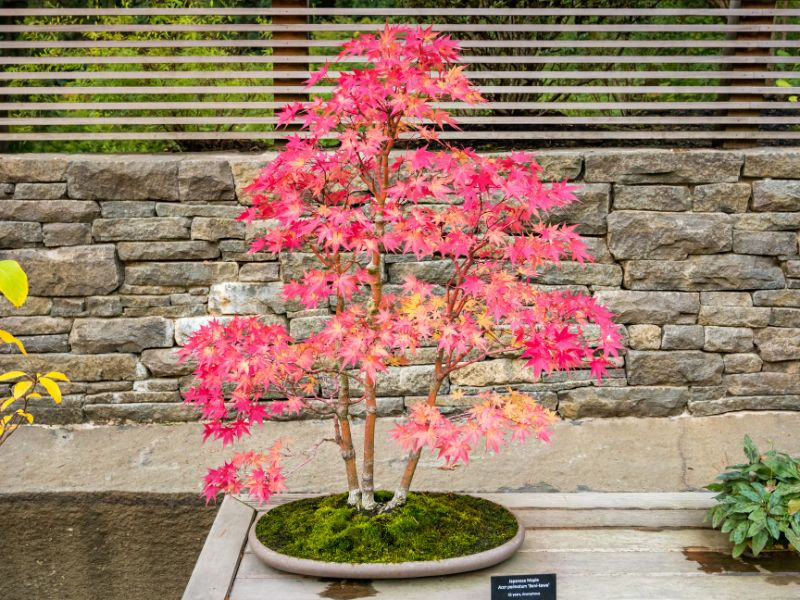
Different tree species have unique requirements, especially when it comes to soil. Just as a maple tree thrives in different conditions than a pine, so do their miniature bonsai counterparts.
Bonsai Tree Soil for Deciduous Trees
Deciduous trees, known for shedding their leaves annually, have specific soil requirements to thrive as bonsai.
- Specific Needs:
- Water Retention: Deciduous trees tend to prefer soil that retains moisture well, as they have a more extended period of active growth compared to some other species.
- Nutrient-Rich: As they go through a robust growth phase, deciduous trees require a bounty of nutrients. Hence, a soil rich in organic material can be particularly beneficial.
- Soil Mix Recommendations:
- A balanced mix incorporating both organic and inorganic components is a key factor in soil in bonsai success. For example, a combination of 60% organic bonsai soil like compost or pine bark with 40% inorganic material such as lava rock or pumice can provide both nutrition and good drainage.
- Due to the active growth nature of deciduous trees, a more frequent replenishment of nutrients through fertilization may be necessary, especially if the soil is more skewed towards inorganic components.
Bonsai Soil for Other Tree Species
Different bonsai species might come with their own set of challenges and needs.
- Conifers: These trees, which include pines and junipers, often prefer well-draining soil. A mix heavier on inorganic soil components like lava rock or akadama can be ideal. They need consistent moisture but do not fare well in overly wet conditions.
- Tropical and Subtropical Trees: Species like Ficus or Jade can tolerate a more moisture-retentive mix. Hence, a slightly higher percentage of organic soil components might be beneficial for them.
- Fruit-bearing Bonsai: Trees like the pomegranate or crabapple bonsai prefer nutrient-rich soils. While they need well-draining soils, they also benefit significantly from organic soils that offer a consistent release of nutrients.
Common Soil-related Challenges in Bonsai Cultivation
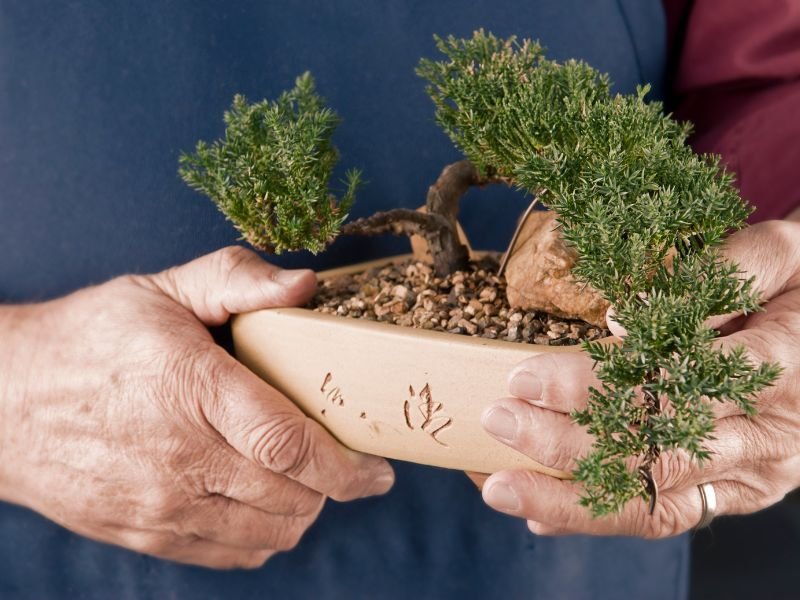
Even with meticulous care, bonsai enthusiasts might sometimes encounter challenges that threaten the health of their miniature trees. Many of these challenges are intrinsically tied to the soil, emphasizing the importance of understanding soil-related issues in bonsai cultivation.
Compacted Organic Soil
- The Dangers of Compacted Soil: Compaction is a common issue, especially with predominantly organic soils. When the soil compacts, it diminishes the pockets of air, inhibiting the flow of fresh air to the roots. This reduction can result in weakened root growth, making the bonsai more susceptible to diseases and stunting its overall growth. Moreover, compacted soil can hinder water drainage, leading to waterlogged conditions that are detrimental for most bonsai species.
- Prevention: Avoiding compacted organic soil is a combination of the right soil mix and proper care techniques:
- Aeration: Regularly aerating the soil is a vital practice for soil in bonsai success, ensuring it doesn’t become too dense. This can be done using a fine stick or a specialized tool to gently prod and loosen the soil without damaging the roots.
- Appropriate Soil Mix: Incorporating inorganic components into the soil mix, such as perlite, lava rock, or sand, can prevent the soil from compacting too tightly.
- Repotting: Over time, as the organic components break down, the soil might naturally compact. Regular repotting, usually every 2-3 years for most bonsai trees, can help in replacing old, degraded soil with fresh bonsai soil mix.
Root Rot and its Connection to Soil
- Identifying Root Rot: Root rot is a disease that, as the name suggests, affects the roots of the tree. Indications might include yellowing or wilting leaves, a foul odor emanating from the soil, or blackened, mushy roots. It’s mainly caused by fungi that thrive in continuously moist, anaerobic conditions.
- The Role of Soil in Its Prevention:
- Drainage: A well-draining soil mixture is the first line of defense against root rot. Ensuring that water doesn’t stagnate in the bonsai pot creates an environment where harmful fungi find it hard to thrive.
- Balanced Watering: Overwatering is a common mistake, especially among bonsai newcomers. The soil should be moist but not perpetually wet. Using a soil surface test, where you feel the top inch of the soil for moisture, can be a handy guide to determine when to water.
- Soil Components: Incorporating materials that prevent water retention, like lava rock, grit, or akadama, can help in minimizing the risk of root rot.
Essential Soil Care Tips for Bonsai Success

A bonsai tree’s success is deeply rooted in the care provided to its soil. After all, the soil is not just the medium where the tree stands but its primary source of nutrients, moisture, and air.
Here are some essential care tips to ensure your bonsai thrives.
Ensuring Fresh Air for Root Growth
- The Importance of Oxygen for Bonsai Tree Roots: While water and nutrients are essential for bonsai trees, oxygen is equally vital. The roots of the tree don’t just anchor it in place; they’re actively engaged in the uptake of water, nutrients, and fresh air. Roots respire, and without adequate oxygen, they can suffocate, leading to stunted growth or even tree death.
- Tips to Ensure Adequate Aeration:
- Regular Aeration: Use a fine tool to gently poke the soil, ensuring pockets of air remain accessible to the roots.
- Soil Mix: Incorporating inorganic soils soil mixes, like lava rock or pumice, can aid in creating air pockets within the soil, preventing compaction.
- Avoid Overwatering: Waterlogged soil can suffocate roots. Always ensure the soil is moist but not drenched.
Monitoring Soil Surface and Moisture Levels
- Tips for Optimal Water Retention Without Oversaturation:
- The Finger Test: Regularly touch the soil surface. If the top inch feels dry, it’s time to water. If it’s moist, wait a day or two.
- Drainage Holes: Ensure your bonsai pot has adequate drainage holes. This feature ensures excess water escapes, preventing oversaturation.
- Mulching: Adding a layer of mulch on the soil surface can aid in retaining moisture while preventing rapid evaporation.
Selecting the Right Bonsai Pot for Your Soil Mix
- The Interplay Between the Bonsai Pot and Soil:
- Drainage: The pot selected should offer excellent drainage, aligning with your chosen soil mix. If you’ve opted for a soil that retains more water, ensure the pot complements this with efficient drainage.
- Size: The depth and width of the pot should accommodate the bonsai tree soil volume necessary for the tree’s roots. While bonsai trees are pruned to remain small, their roots still need adequate space.
- Material: Some pots, like unglazed clay pots, are porous and can assist in moisture regulation. If you’re using a soil mix with higher water retention, such pots can be beneficial.
Carefully tending to the soil is a journey of patience and learning. But with these essential tips, that journey can lead to a thriving, beautiful bonsai that stands as a testament to your dedication and care.
Embracing Soil’s Vital Role in Bonsai Mastery
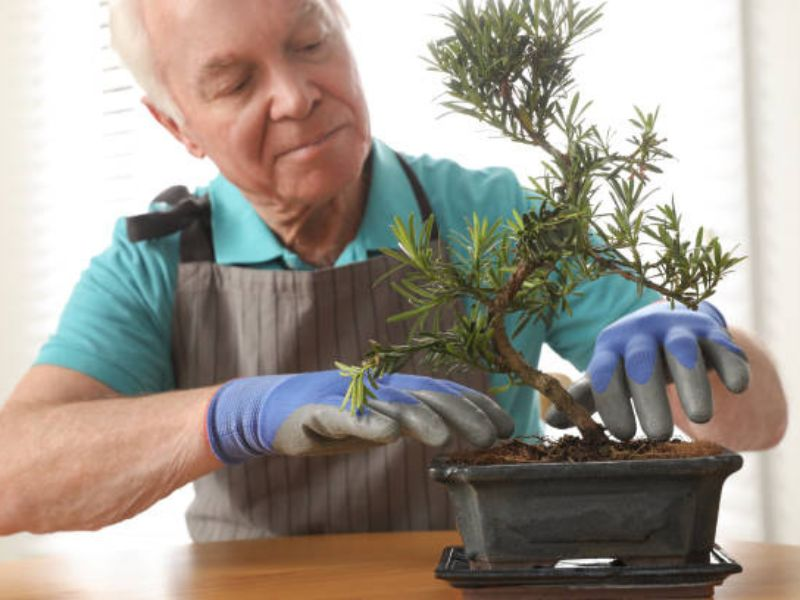
As we’ve journeyed through this article, it’s evident that a deep understanding of soil is pivotal to mastering the art of bonsai cultivation and achieving success with bonsai soil. But knowledge is just the beginning. Application, experimentation, and continual learning are what truly set the path to bonsai mastery.
Now, it’s your turn to take action:
- Dive Deep: Revisit sections of this guide that resonated with you. Whether it’s the intricacies of organic vs. inorganic soil components or the specific needs of different bonsai species, immerse yourself in the details.
- Experiment Confidently: Don’t be afraid to test out various soil mixes or to adjust components based on your bonsai’s unique needs. Remember, sometimes the most unexpected combinations yield the most exceptional results.
- Join the Community: Engage with fellow bonsai enthusiasts, share your experiences, ask questions, and learn from others. Together, we cultivate not just bonsai trees but a thriving, knowledgeable community.
- Stay Updated: Bonsai, as an art, is ever-evolving. New techniques, research, and insights emerge regularly. Subscribe to our newsletter and stay at the forefront of bonsai soil knowledge.
Ready to delve deeper into the world of bonsai and truly embrace soil’s transformative power? Let’s embark on this journey together. Dive in, experiment, and let the magic of the soil guide your bonsai to unparalleled success.


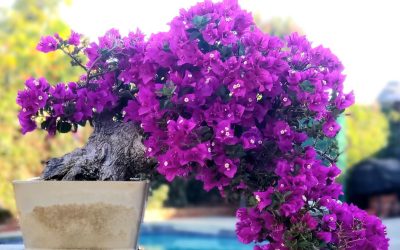
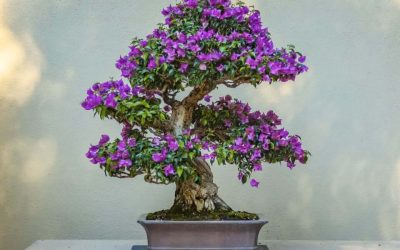
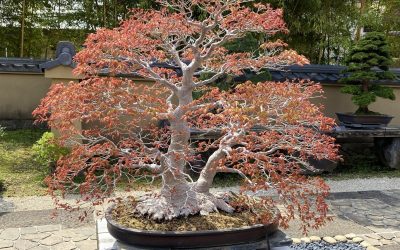
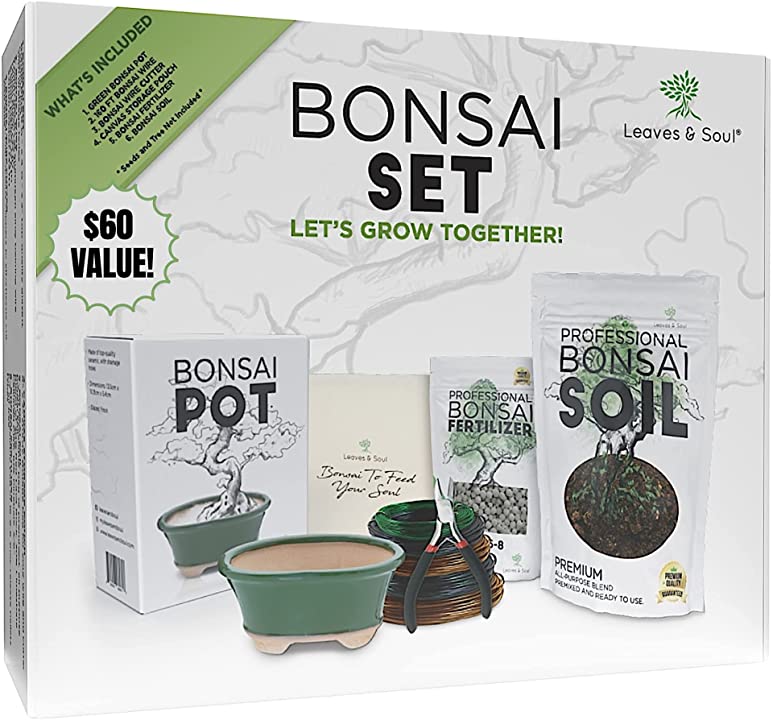
0 Comments